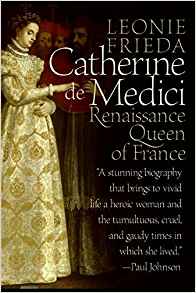
by fljustice | Jan 28, 2011 | Biographies, Books, Reviews, Wonderful Women
“Catherine de Medici: Renaissance Queen of France” by Leonie Frieda
Long, long ago in a youth far, far away, I read a biography of Catherine de Medici, so I was already familiar with her story. I have to admit, the details were hazy: I remembered something about poison, religious wars and that she was Mary, Queen of Scots’ mother-in-law. Then a couple of years ago, my husband and I took a biking vacation in the Loire valley and visited numerous castles and gardens along way, several associated with Catherine and her rival Diane de Poitiers; so I was reacquainted with the general outlines of her story. Which brings me to: Catherine de Medici: Renaissance Queen of France by Leonie Frieda.
 From the Introduction:
From the Introduction:
“Catherine de Medici has variously been called ‘The Maggot from Italy’s Tomb’, ‘The Black Queen’ and ‘Madame La Serpente’. To many she is the very incarnation of evil. It is, I believe, as mistaken a judgment as it is bigoted. Yet it is not far removed from the overall verdict of history on one of the most remarkable women of the sixteenth century.” (more…)
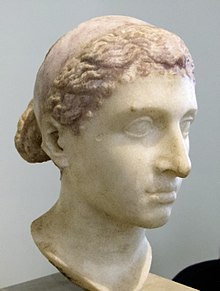
by fljustice | Jan 21, 2011 | History, History in the News
History in the News:
Cleopatra’s Needle, New Human Cousins and Bog Bodies
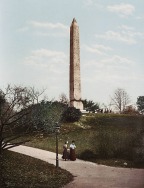
Cleopatra’s Needle, 1901
One of the delights of living in NYC is Central Park. It’s not only a green space and refuge for weary urbanites, it’s the site of many monuments; some are gifts from other countries. One of the most magnificent is the 3,500-year-old granite obelisk commemorating King Thutmose III, commonly known as Cleopatra’s Needle, situated on a rise in back of the Metropolitan Museum of Art. This ancient artifact is one of a pair originally situated in Heliopolis, Egypt. The Romans moved them in 12 B.C. to adorn a temple in Alexandria. In 1877, the Khedive of Egypt gave one of the obelisks to the US. It was erected in Central Park in 1881 after an epic two and half year journey. It has sat in the New York climate ever since. Zahi Hawass, the secretary general of Egypt’s Supreme Council of Antiquities, recently posted on his blog a letter he sent to the Central Park Conservancy and Mayor Bloomberg, complaining about lack of proper care for the monument. He said, “I will take the necessary steps to bring this precious artifact home and save it from ruin.” The hieroglyphics are significantly eroded and many people believe the weathering occurred during the last century. The Conservancy denies that the monument has been neglected. This blog post uses photos to show the obelisk was already in poor shape when it arrived. Dr. Hawass is probably in error about when the erosion happened, but his complaint may spur the city and the Conservancy to make sure it doesn’t deteriorate further. I’ll update this post if the controversy continues. (Link to original article.) (more…)
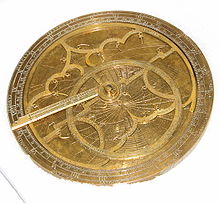
by Faith Justice | Aug 18, 2010 | History, History in the News
History in the News:
Pyroclastic Clouds, Dead Dogs, and Ads on the Coliseum
As I’ve said on my About page, I’m a history junkie and science geek. I love the intersection of these two disciplines: DNA markers that trace humankind’s exodus from Africa, isotope analysis of teeth and bones that tell us where and when ancient people grew up and what they ate, UV light to fluoresce bones and fingerprints on artifacts, and much more. Over half of my “history in the news” stories this round up have a major science component–from what really killed people in Pompeii to discovering a “lost” Roman city from aerial photographs to where the Dead Sea Scrolls were manufactured. You can click on the links to see the original stories. We’ll start with Pompeii.
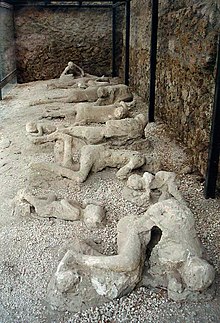 Most historians and archaeologists believed the people at Pompeii, who where not killed by spewing rocks, died of suffocation from ash and poisonous gas. Pliny the Younger described the process in letters written 25 years later. Giuseppe Mastrolorenzo, a vulcanologist from the Naples Observatory claims “Everything that has been written in the guides, and the texts, and that has been re-told to tourists [about how people died at Pompeii] is false.” He spent years analyzing skeletal casts, testing bone tissue and simulating Vesuvius eruptions. He published his findings in the science journal PLoS One. Mastrolorenzo concludes that the people of Pompeii were instantly killed by a pyroclastic cloud, a surge of super-heated air. He also proved these high temperatures can be carried up to 12 miles away from the volcano. The Italian Civil Protection requires only those people living five miles from Vesuvius to evacuate, which puts 3 million people in and around Naples in harm’s way, in case of another eruption.
Most historians and archaeologists believed the people at Pompeii, who where not killed by spewing rocks, died of suffocation from ash and poisonous gas. Pliny the Younger described the process in letters written 25 years later. Giuseppe Mastrolorenzo, a vulcanologist from the Naples Observatory claims “Everything that has been written in the guides, and the texts, and that has been re-told to tourists [about how people died at Pompeii] is false.” He spent years analyzing skeletal casts, testing bone tissue and simulating Vesuvius eruptions. He published his findings in the science journal PLoS One. Mastrolorenzo concludes that the people of Pompeii were instantly killed by a pyroclastic cloud, a surge of super-heated air. He also proved these high temperatures can be carried up to 12 miles away from the volcano. The Italian Civil Protection requires only those people living five miles from Vesuvius to evacuate, which puts 3 million people in and around Naples in harm’s way, in case of another eruption.
(more…)

by Faith Justice | Jul 18, 2010 | History, History in the News
History in the News:
Bones, Poison, and Treasure

Bust of Cleopatra VII in Berlin
I’ll be doing a regular round up of archaeology and history stories that make it into the mainstream press every couple of weeks with links to the original stories. The focus will be on Roman history, but anything that catches my fancy will be fair game. This post features several finds in Britain including a hoard of coins, a controversial skeleton initially thought to be a female gladiator, and the graves of 97 infants; Roman frescoes, canals and looted artifacts; and renewed speculation over Cleopatra’s death. Snakebite or poison?
I don’t know if it’s because the stories are printed in English, Britain has an abundance of archaeologists and amateur treasure hunters, or some other fluke of randomness, but fully half the stories that caught my attention this round up are from Britain. We’ll start with the bones and end with the treasure.
In Caistor (from the Anglo-Saxon ceaster meaning Roman camp or town), archaeologists have discovered a large, well-organized late Roman cemetery. They’ve recovered 46 sets of human remains from the site of the derelict Talbot Inn which is being redeveloped into a Lincolnshire cooperative food store. The remains – including complete skeletons – will be studied and reburied. Colin Palmer-Brown, Director of the Pre-Construction Archaeological Services Ltd team overseeing the site believes there are “hundreds if not thousands of people buried in this part of Caistor.”
(more…)

by Faith Justice | Jun 25, 2010 | Essays/Research, Writing
Historical Research Using Internet, Interviews and Site Visits
 In Part I of this two-part series, I talked about using books and libraries in doing historical research. Although print matter is a good place to start, in today’s world you can’t ignore the Internet. But there are two problems: quantity and quality – too much of the former and not enough of the latter. Unlike traditionally published books, which have to go through some screening process (in academic circles that can be quite rigorous), anyone can put anything up on the Net and pass it off as truth. So what’s a good historical fiction writer to do?
In Part I of this two-part series, I talked about using books and libraries in doing historical research. Although print matter is a good place to start, in today’s world you can’t ignore the Internet. But there are two problems: quantity and quality – too much of the former and not enough of the latter. Unlike traditionally published books, which have to go through some screening process (in academic circles that can be quite rigorous), anyone can put anything up on the Net and pass it off as truth. So what’s a good historical fiction writer to do?
Stick to sites that have some stake in maintaining their reputation for accuracy such as universities and historical, archaeological and professional societies. Many sites not only update articles, but blog and tweet as well. Others aggregate the news. The Archaeological Institute of America has a daily update of archaeology in the news. When you find interesting aggregators, subscribe to their RSS feed, get email alerts or tweets when new information is posted. Google also has Google Scholar (click on the “more” button at the Google.com home page) that searches professional and scholarly literature. Many newspapers and local government organizations have digitized their archives and can be a great source of primary material. (Remember your best friend the research librarian? Tap them for help on accessing those databases.)
(more…)

by Faith Justice | Jun 8, 2010 | Agora, Essays/Research, History, Hypatia, Movies, Reviews, Wonderful Women
Agora: the “Reel” vs. the “Real” Hypatia – Part III
 In Parts I & II of this series on the history behind the movie, I talked about several major historical events of the times and a couple of my favorite anecdotes that made it into the film. In Part III, I’ll look at the major characters, how they were portrayed in the film and what we know about their real lives. Because I’ve written so extensively about Hypatia (essays, guest blogs, a novel, and a non-fiction book) I’ll save her for last. (more…)
In Parts I & II of this series on the history behind the movie, I talked about several major historical events of the times and a couple of my favorite anecdotes that made it into the film. In Part III, I’ll look at the major characters, how they were portrayed in the film and what we know about their real lives. Because I’ve written so extensively about Hypatia (essays, guest blogs, a novel, and a non-fiction book) I’ll save her for last. (more…)








